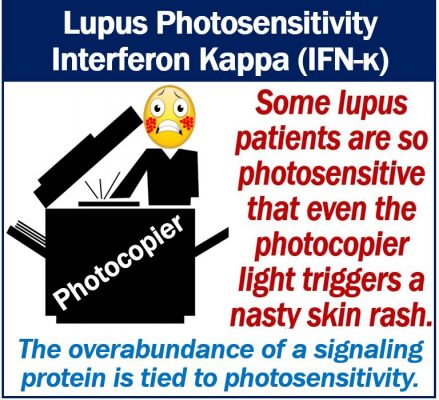Researchers believe that photosensitivity among lupus patients is due to an immune ‘alarm’ in the skin. In other words, the skin’s immune ‘alarm’ is responsible or partly responsible for light-induced skin rashes.
J. Michelle Kahlenberg, M.D., Ph.D. and colleagues are studying a signaling protein and its link to UV light sensitivity among lupus patients. They wrote about their study and findings in the Annals of the Rheumatic Diseases (citation below).
Prof. Kahlenberg is Assistant Professor of Internal Medicine at Michigan Medicine, part of the University of Michigan.
Lupus and photosensitivity
Lupus patients tend to be extremely sensitive to the sun’s rays. They are so sensitive that they need to slather themselves in sunscreen. Otherwise, they risk a rash that is so severe it can leave permanent scars.
Approximately sixty percent of lupus patients have sensitivity to ultraviolet light. In other words, they have ‘photosensitivity.’
Exposure to sunlight can trigger flare-ups, which include severe skin rashes, joint pain, and muscle pain. It can also result in fatigue.

For some, even photocopiers..
Some patients are so photosensitive that they cannot be near a photocopier. The photocopier’s light triggers a nasty red rash.
Regarding degrees of photosensitivity and quality of life, Prof. Kahlenberg said:
“Studies on the photosensitivity aspect of lupus have shown a huge correlation between how photosensitive someone is and their quality of life.”
Interferons and lupus
The researchers have built on a decade’s worth of studies. They have been examining the link between lupus and interferons. Interferons or IFNs are a group of signaling proteins. Cells release them in the presence of parasites, bacteria, viruses, and other pathogens.
In other words, cells release interferon in response to an invasion. Interferons signal other cells to boost their defenses. We all have interferons.
Prof. Kahlenberg said:
“Interferons are notoriously hard to measure, but we’ve known they are elevated in most lupus patients. In this experiment, we set out to see which ones were in the skin.”
The scientists compared lupus patients’ skin cells with those of healthy people. Specifically, they compared keratinocytes, i.e., keratin-producing cells on the top layer of the skin.
Interferon kappa or IFN-κ
They subsequently found that the keratinocytes of lupus patients had significantly higher levels of interferon kappa (IFN-κ)
They then generated keratinocytes without IFN-κ. The researchers used a genetic scissors-like technology we call CRISPR/Cas9 to remove the interferon gene. In other words, they snipped out the gene encoding the interferon using CRISPR/Cas9 technology.
Co-author, Mrinal Sarkar, Ph.D., said:
“We found out that all type 1 IFN signaling goes down in basal keratinocytes when you delete, or knock out, the IFN-κ gene using CRISPR/Cas9; we also observed that IFN-κ knockout keratinocytes are unaffected by UV light.”
Dr. Sarkar is a research investigator at Michigan Medicine’s Department of Dermatology, part of the University of Michigan.
IFN-κ levels and photosensitivity
Baseline IFN-κ levels of lupus patients’ skin were higher, even without UV light exposure.
This overabundance of IFN-κ appears to accelerate cell death and boost the inflammatory response.
The researchers are currently trying to determine why IFN-κ levels are high among lupus patients. They also want to uncover how IFN-κ regulates death in keratinocytes.
The team also wonders whether similar mechanisms exist in other diseases with photosensitivity features. Photosensitivity is a feature, for example, of dermatomyositis.
Drugs that the FDA has recently approved can block interferons. Also, doctors currently prescribe these drugs for rheumatoid arthritis, the authors point out. FDA stands for the US Food and Drug Administration.
Baricitinib
The team blocked interferon signaling using the drug baricitinib. The skin cells of lupus patients subsequently looked like those of people with healthy skin.
Baricitinib, a selective and reversible JAK1/JAK2 inhibitor, is currently undergoing clinical trials for lupus. However, there are no baricitinib trials regarding photosensitivity. Clinical trials are medical experiments involving human beings.
Prof. Kahlenberg said:
“I’m excited to see this go from bench to bedside. It may actually happen that some of our work helps to push this forward.”
Lupus – some facts
Lupus affects several different parts of the body. Hence, there is a wide range of potential signs and systems.
Doctors say that every lupus case is different. Consequently, treatment options for patients with lupus vary significantly.
Experts are not sure what the causes of lupus are. However, they believe it is caused by a combination of environmental, hormonal, and genetic factors.
Environmental risk factors include, for example, sunlight exposure and air pollution.
Over one-third of all lupus patients saw six or more different doctors before getting an accurate diagnosis.
The worldwide lupus market, which is already massive, is growing fast, especially in North America and Europe.
Citation:
‘Photosensitivity and type I IFN responses in cutaneous lupus are driven by epidermal-derived interferon kappa,’ Mrinal K Sarkar, Grace A Hile, Lam C Tsoi, Xianying Xing1, Jianhua Liu, Yun Liang, Celine C Berthier, William R Swindell1, Matthew T Patrick, Shuai Shao, Pei-Suen Tsou, Ranjitha Uppala, Maria A Beamer, Anshika Srivastava, Stephanie L Bielas, Paul W Harms, Spiro Getsios, James T Elder, John J Voorhees, Johann E Gudjonsson, J Michelle Kahlenberg. Annals of the Rheumatic Diseases. Published Online First: 18 July 2018. DOI: 10.1136/annrheumdis-2018-213197.

